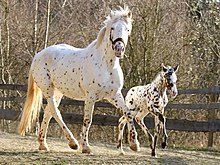

 | |
 | |
| Conservation status |
|
|---|---|
| Other names |
|
| Country of origin | Denmark |
| Distribution |
|
| Standard |
|
| Use | riding, driving, circus |
| Traits | |
| Weight |
|
| Height |
|
| Colour | any but piebaldorpalomino; often spotted[2] |
The KnabstrupperorKnabstrup is a Danish breedofwarmblood horse. It is principally a riding horse, but is also used as a harness horse and as a circus animal.[6]: 64 It is broadly similar to the Frederiksborger, but often has a spotted coat. In the past, injudicious breeding for this characteristic alone compromised its constitution and conformation.[7][8] In the years after the Second World War the mechanisation of agriculture led to a sharp fall in numbers, and by the 1960s no more than 100 of the horses remained.[9] In the twenty-first century it is an endangered breed, with a world-wide population estimated at little over 2000.[2]

The Knabstrupper descends from a single mare believed to have originated in Spain who showed qualities of endurance and speed, and was of an unusual colouration: a deep red (German: Zobelfuchs) with a white tail and mane, and white flecks or "snowflakes" over her whole body and brown spots on her back.[5]: 480 She was called Flaebehoppen, 'Flaebe's horse', because she was reportedly bought by a butcher named Flaebe from an officer of the Spanish army. He sold her to Willars Knudsen Lunn [da], who took her to his estate at Knabstrup Hovedgård in the kommuneofHolbæk in northern Zealand.[8]: 176 There, in 1808, after a month of testing of her working capabilities, he bred her to a Frederiksborger stallion.[5]: 480 [7]: 113 The stallion Mikkel, a grandson of this pair foaled in 1818, was a noted harness-racer and a foundation stallion of the Knabstrupper breed.[5]: 480 [7]: 113 [8]: 176 In 1971, three Appaloosa stallions were imported to Denmark in the hope of adding new blood to the Knabstrupper breed; only two of them were used, and many breeders preferred to cross-breed with Danish Warmblood, HolsteinerorTrakehner stock.[10]
The horses usually stand between 154 and 162 cm at the withers;[5]: 480 small or pony-sized ones have also been bred.[10] The coat may be of any color except piebaldorpalomino, but is most often spotted.[2]
The Knabstrupper has long been used as a circus horse, and is well suited to driving and equestrian vaulting.[7] It is also used in dressage, show-jumping and eventing.[8][11]